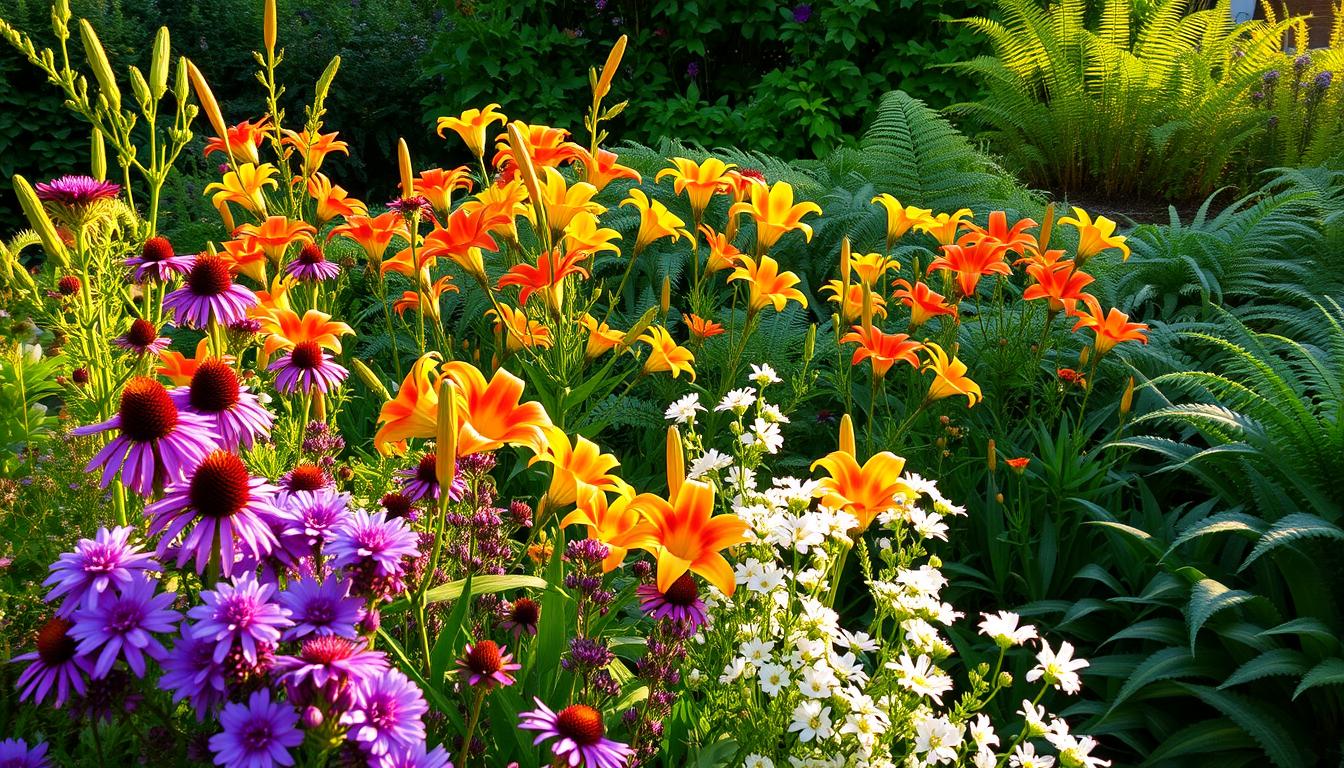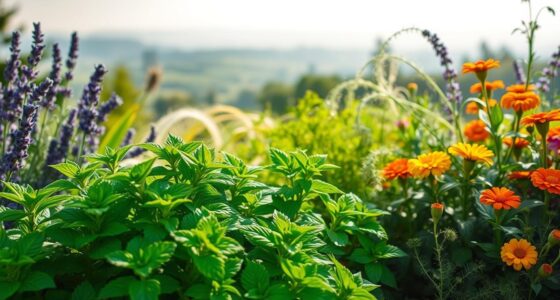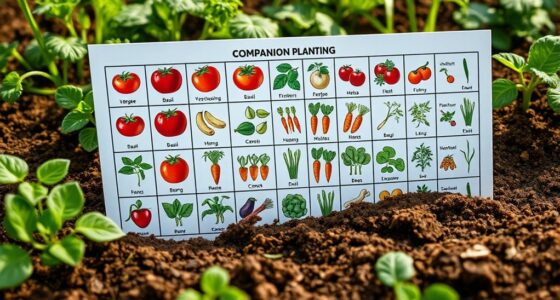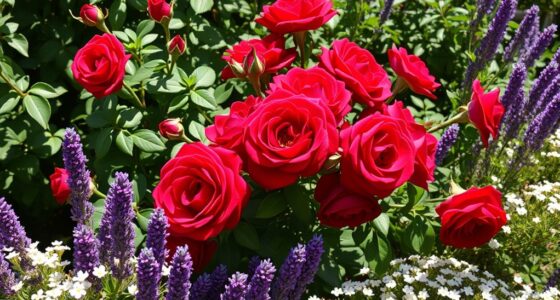Imagine stepping into your garden, greeted by the vibrant colors and delightful scents of blooming daylilies. These flowers, with their graceful petals and kaleidoscope of shades, have a unique ability to lift your spirits. As you admire their beauty, it’s easy to overlook the secret companions that help them thrive. Finding the right daylily companion plants can transform your garden into a lush paradise. Not only do these partners create stunning visual contrasts, but they also enhance growth and soil health, resulting in a balanced ecosystem. Let’s explore some of the best plants for daylilies and discover how they can enrich your garden experience and strengthen the bond between nature and your backyard.
Key Takeaways
- Daylilies thrive best with companion plants that offer both aesthetic appeal and practical benefits.
- Understanding the ideal growing conditions is essential for pairing the best plants for daylilies.
- Companion planting fosters healthier plants by improving soil quality and promoting pest control.
- Certain perennials to plant with daylilies can create stunning visual displays and ecological balance.
- Experimenting with different companions can lead to a more vibrant and resilient garden.
Understanding Daylilies and Their Needs
Daylilies, known scientifically as Hemerocallis, have captured the hearts of gardeners due to their stunning blooms and robust nature. Understanding daylilies begins with an appreciation for their resilience. These plants thrive in a variety of conditions, making them versatile additions to diverse garden layouts. Their vibrant flowers bring life to your outdoor space while needing minimal care.
Why Daylilies Are Popular
One key reason for the popularity of daylilies is their adaptability. They can flourish in different environments, showcasing a range of colors and forms. Beyond their visual appeal, they are relatively low-maintenance, making them ideal for both novice and seasoned gardeners. By recognizing the daylily needs, you ensure a rewarding gardening experience without excessive effort.
Ideal Growing Conditions
Understanding daylilies includes acknowledging their ideal growing conditions. These flowers prefer well-drained, slightly acidic soil. Poor drainage can lead to challenges, such as root rot. When you prepare a suitable space for them, success becomes far more attainable. Observing proper daylily growing conditions allows you to create an environment where these plants can unfold in full splendor.
Sunlight and Water Requirements
Daylilies require full sun to perform at their best. Aim for at least six hours of direct sunlight each day. This exposure not only ensures vibrant blooms but also strengthens the plant’s structure. Equally important is their water requirement; these plants appreciate regular moisture but do not fare well in overly wet soil. By understanding the balance between sun and water, you can nurture the health and beauty of your daylilies.
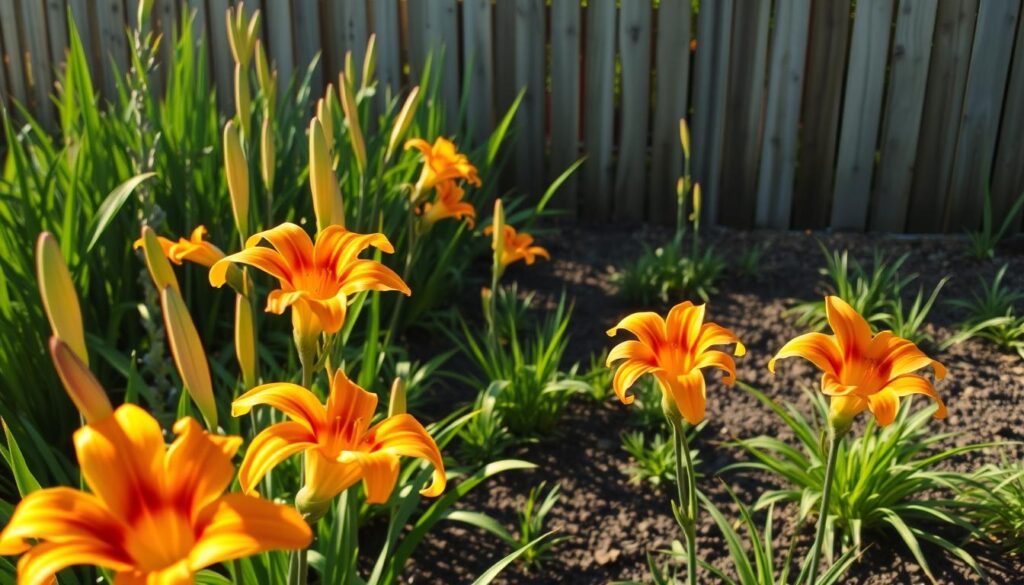
| Aspect | Ideal Condition |
|---|---|
| Soil Type | Slightly acidic, well-drained |
| Sunlight | 6+ hours of direct sunlight |
| Watering | Regular moisture, avoid overwatering |
Benefits of Companion Planting
Companion planting offers numerous advantages for your garden, particularly in maximizing the health and productivity of daylilies. By strategically pairing plants, you can experience multiple benefits of companion planting that contribute to a flourishing garden environment.
Enhancing Growth and Health
One significant benefit of companion planting is its role in enhancing growth. When you position compatible plants together, they can optimize space and share resources effectively. This arrangement leads to healthier and more vibrant daylilies, as their growth is supported by their neighbors. Benefits include improved nutrient uptake, which can lead to robust blooms and overall plant vitality.
Pest Control through Companionship
Pest control is another key advantage associated with companion planting. Certain plants naturally repel pests that can harm daylilies. For example, marigolds are known to deter nematodes, while basil repels flies and mosquitoes. By grouping plants that attract beneficial insects, such as ladybugs and lacewings, you can create a natural defense system against pests, thus promoting a healthier garden ecosystem.
Improving Soil Quality
With companion planting, you benefit from improved soil quality. Some plants, like legumes, have the unique ability to fix nitrogen in the soil, enriching it for neighboring plants. This enhancement supports the growth of daylilies and can help maintain a balanced nutrient profile in your garden. As you cultivate diverse plant pairings, your soil becomes a thriving medium that supports a variety of plant life.

| Benefit | Description |
|---|---|
| Enhanced Growth | Optimizes space and resources leading to healthier plants. |
| Pest Control | Naturally deters harmful insects and attracts beneficial predators. |
| Improved Soil Quality | Enriches soil nutrients and enhances growth potential for all plants. |
Best Companion Plants for Daylilies
Choosing the best plants for daylilies enhances their beauty and health. When planning your garden, consider the unique qualities of daylily garden companions. In this section, you’ll discover some of the top daylily companion plants from a curated list that brings out the best in your garden.
Hostas: A Shady Pairing
Hostas thrive in shady areas, making them an excellent match for daylilies. Their lush foliage complements daylily blooms beautifully, adding texture and contrast to your garden. Hostas also require similar moisture levels, ensuring a harmonious growth environment.
Sedums: Thriving with Daylilies
Sedums are resilient plants that excel in similar conditions as daylilies. They require less water and can tolerate drought, making them a fantastic choice for sunny borders. Their fleshy leaves and attractive flowers provide more visual interest, ensuring that your daylily garden remains vibrant throughout the season.
Coneflowers: Vibrant Color Combinations
Coneflowers bring striking colors that blend well with daylily blooms. These perennials not only provide vibrant hues but also attract beneficial pollinators. Planting coneflowers alongside daylilies ensures a continuous spectacle of color as they often bloom at different times, contributing to a lively garden atmosphere.
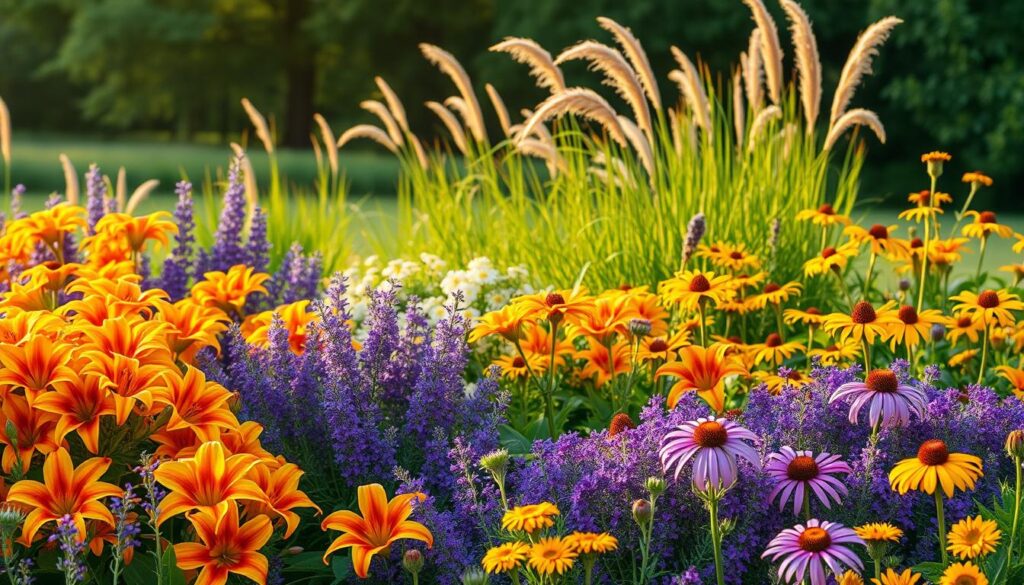
| Companion Plant | Benefits | Water Needs |
|---|---|---|
| Hostas | Provides texture and contrast | Moderate |
| Sedums | Thrives in dry conditions | Low |
| Coneflowers | Attracts pollinators | Moderate |
Herbs That Complement Daylilies
Incorporating herbs into your garden can enhance both the aesthetics and functionality of your planting scheme. When thinking about daylily companion planting ideas, consider the benefits of using culinary herbs. These herbs not only perfume your meals but also promote healthy growth for your daylilies. They share similar growing conditions and offer unique advantages by repelling pests and attracting beneficial insects.
Basil: Aromatic and Useful
Basil thrives in well-drained soil and full sunlight, making it a perfect companion for daylilies. This herb can deter aphids and other pests while providing fresh leaves for culinary delights. When you intersperse basil among your daylilies, you create a fragrant and functional garden space.
Chives: Flavor and Foliage
Chives are an easy-to-grow culinary herb that complements daylilies beautifully. Their green, onion-like foliage offers a striking contrast to the vibrant daylily blooms. Chives are known to deter harmful insects, and their delicate purple flowers attract pollinators, enriching the ecosystem of your garden.
Oregano: A Low-Maintenance Choice
Oregano stands out as a low-maintenance herb that pairs well with daylilies. It prefers similar sunlight and soil conditions, thriving alongside your flowers. Adding oregano to your garden not only provides culinary benefits but also adds texture and depth to your landscape.
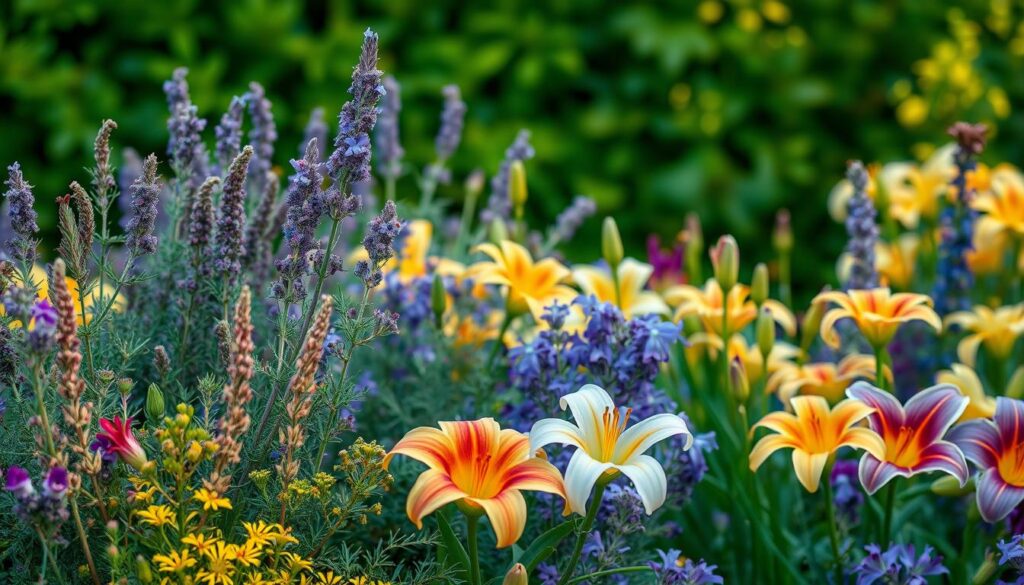
| Herb | Benefits | Growing Conditions |
|---|---|---|
| Basil | Deters pests, enhances flavor | Full sun, well-drained soil |
| Chives | Attracts pollinators, repels harmful insects | Full sun, well-drained soil |
| Oregano | Low-maintenance, adds texture | Full sun, well-drained soil |
Attracting Pollinators with Companions
Creating a garden that thrives on beauty and harmony involves selecting the right companion plants for daylilies. Utilizing pollinator-friendly plants not only enhances your landscape but also promotes ecological health. Certain plants, like butterfly bushes and lavender, have become iconic choices due to their ability to draw various beneficial insects into your garden.
Butterfly Bushes: A Magnet for Butterflies
Butterfly bushes stand out in any garden, attracting butterflies with their vibrant blooms and sweet fragrance. These stunning pollinator-friendly plants create a lively atmosphere as they invite these beautiful insects to flutter among your daylilies. By incorporating butterfly bushes, you enrich the environment, fostering an ecosystem that benefits both plants and pollinators alike.
Lavender: Fragrant and Inviting
Lavender offers a delightful fragrance along with its striking purple hues. This aromatic herb not only enhances your garden’s aesthetic but also acts as a beacon for attracting beneficial insects. Its dense flower spikes provide a rich nectar source, making it an excellent companion plant for daylilies. The combination not only pleases the senses but also encourages a thriving insect population.
Bee Balm: Bright and Beneficial
With its bright red and pink blooms, bee balm serves as another fantastic option for attracting beneficial insects. This vibrant plant thrives alongside daylilies, allowing for a stunning visual display while drawing in bees, butterflies, and hummingbirds. By incorporating bee balm into your garden, you contribute to a healthier ecosystem filled with various pollinator-friendly plants.
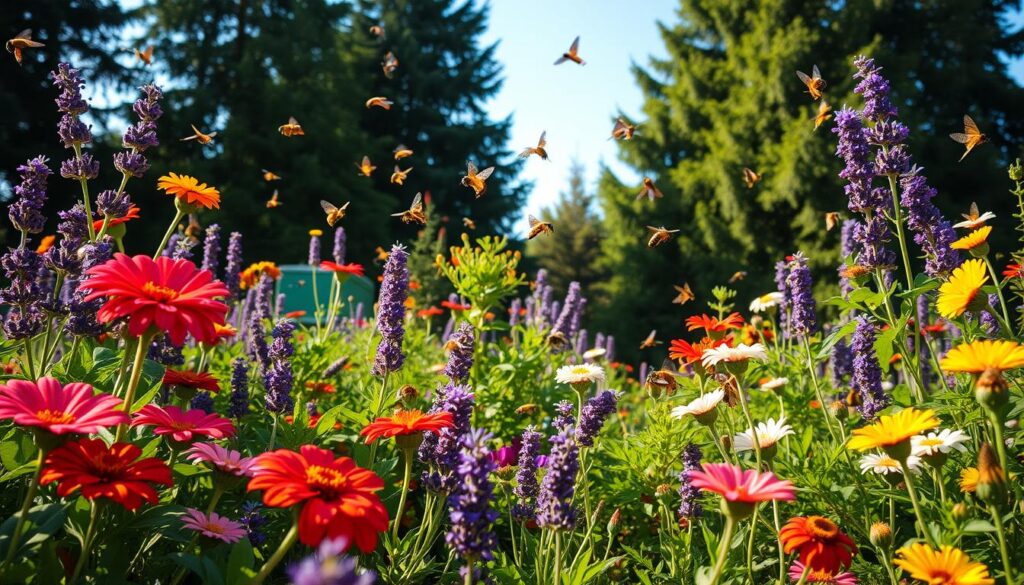
Companion Plants for Different Daylily Varieties
Choosing companion plants for different daylily varieties can enhance the beauty and health of your garden. Each type of daylily has unique characteristics that determine which plants thrive alongside them. By understanding the specific needs of your daylilies, you can create a harmonious garden that showcases their vibrant blooms.
Tall Daylilies: Matching with Sturdy Plants
Tall daylilies often require sturdy companions to balance their height and provide support. Consider pairing them with ornamental grasses such as Pennisetum alopecuroides or Calamagrostis acutiflora, which add texture and movement. These companion plants for tall daylilies not only complement their stature but also thrive in similar growing conditions, ensuring a thriving garden environment.
Miniature Varieties: Perfect Partners
Miniature daylilies offer a compact form that can benefit from nearby plants that enhance their delicate blooms. Use small-flowered annuals like lobelia or calibrachoa to create a visually appealing display. These companions provide a pop of color and can fill the spaces around miniature daylilies without overwhelming them.
Reblooming Daylilies: Seasonal Companions
When planting reblooming daylilies, aim for seasonal companions that extend the flowering period of your garden. Crocosmia and coreopsis are excellent options, providing blooms at different times. This strategy ensures continuous color throughout the growing season, making your garden a vibrant spectacle of flowers.
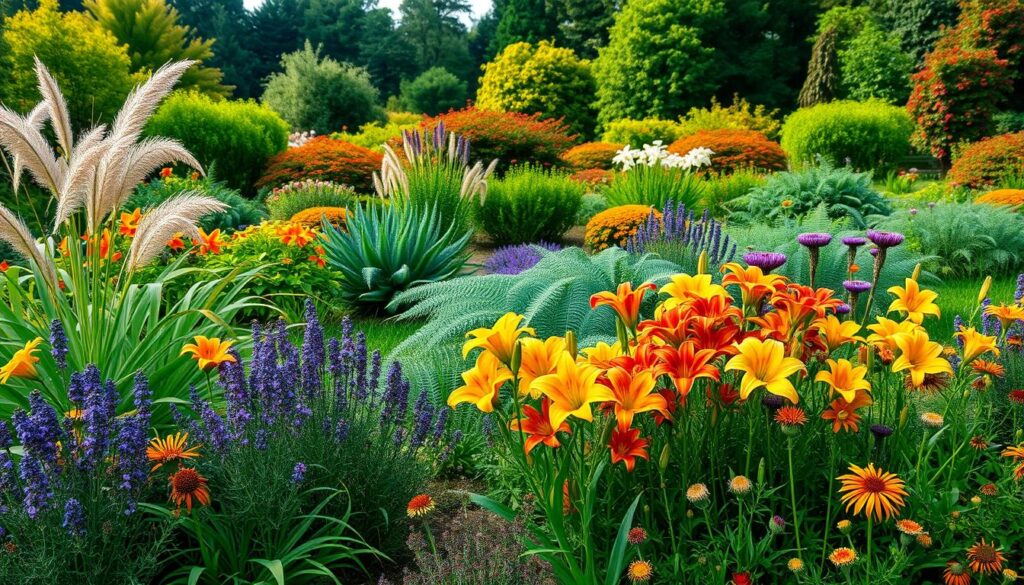
Companion Plant Care Tips
Caring for companion plants enhances the growth and health of both daylilies and their partners. Proper soil preparation and solid watering strategies significantly influence plant success. Let’s explore how to ensure your garden thrives.
Soil Preparation for Companion Plants
Soil preparation is crucial for establishing a healthy environment for daylilies and their companions. Aim for well-drained, moderately rich soil that balances nutrients adequately. Testing your soil’s pH can provide insights on amendments needed for optimal growth. Some suggestions for effective soil preparation include:
- Incorporating organic matter, such as compost or aged manure, to enrich the soil.
- Ensuring good drainage by mixing in sand or perlite if your soil retains too much moisture.
- Adding mulch to maintain soil moisture and suppress weed growth.
Watering Strategies for Success
When watering daylilies, it’s essential to strike a balance between moisture retention and avoidance of overwatering. Consistent watering is vital, especially during dry spells, but be mindful of how much water you apply. Here are some tips for effective watering:
- Water early in the morning to reduce evaporation and fungal diseases.
- Check the topsoil; if the top inch feels dry, it’s time to water.
- Use drip irrigation or soaker hoses to deliver moisture directly to the roots, preventing water waste.

Timing Your Planting
Understanding the timing of your planting can greatly influence the health and beauty of your garden. When planning the planting schedule for daylilies and their companions, consider both spring and fall as crucial times for the best results. Each season offers distinct advantages that can lead to a thriving landscape.
Spring Planting Tips
The best time to plant daylilies is during the spring. This allows them ample time to establish themselves as the weather warms up. Early spring planting gives you the opportunity to enjoy vibrant blooms by summer. Ensure that the soil is well-prepared, and be ready to provide regular watering as the temperatures rise.
Fall Companion Planting
Fall planting serves as another strategic opportunity, particularly for perennials and companions. Planting during this season helps your plants develop robust root systems before winter sets in. With a proper planting schedule, you can ensure that the daylilies and their partners awaken refreshed and ready for the growing season ahead.

Common Mistakes in Companion Planting
Companion planting may seem straightforward, yet many gardeners encounter common planting mistakes that could undermine their efforts. Recognizing these pitfalls can lead to a thriving garden filled with beautiful daylilies and their perfect partners.
Overcrowding Your Daylilies
One significant issue is overcrowding plants in your garden. Daylilies require sufficient space to grow, and when you place too many companion plants nearby, it can lead to competition for resources such as sunlight, water, and nutrients. This competition can negatively impact the health and vigor of your daylilies, stunting their growth and overall performance. Always plan for adequate spacing to ensure that each plant can flourish, creating a balanced and harmonious garden.
Choosing Incompatible Plants
Selecting incompatible plants poses another challenge for successful companion planting. Different types of plants often have unique needs regarding moisture, soil type, and sunlight exposure. When you pair plants that require drastically different conditions, it can jeopardize the success of your garden. For example, combining drought-tolerant daylilies with moisture-loving companions can lead to poor growth for both. Evaluate the needs of your chosen plants to create a thriving ecosystem.

Seasonal Companionship: What to Expect
Observing seasonal plant changes is essential for creating a flourishing garden filled with daylilies and their companions. As the seasons shift, particularly from spring to summer, the dynamics in your garden will evolve. Understanding these transitions will enhance the vibrancy and health of your plantings.
Spring Growth Changes
During spring, you will notice significant growth in both daylilies and their surrounding companions. This period is marked by robust spring growth as plants awaken from winter dormancy. Daylilies flourish and begin to show their foliage, while companion plants may provide necessary support and nutrients. Ensuring proper care, such as adequate watering and fertilization, fosters a strong foundation for the upcoming summer blooms.
Summer Flowering Patterns
As spring transitions into summer, beautiful summer flowers begin to emerge. The vibrant hues of daylilies harmonize with those of companion plants, creating a visually stunning display. At this phase, the interactions among the plants contribute to a lively ecosystem, supporting pollinators and enhancing garden aesthetics. Maintaining a thoughtful planting arrangement yields rich rewards throughout the warm months.
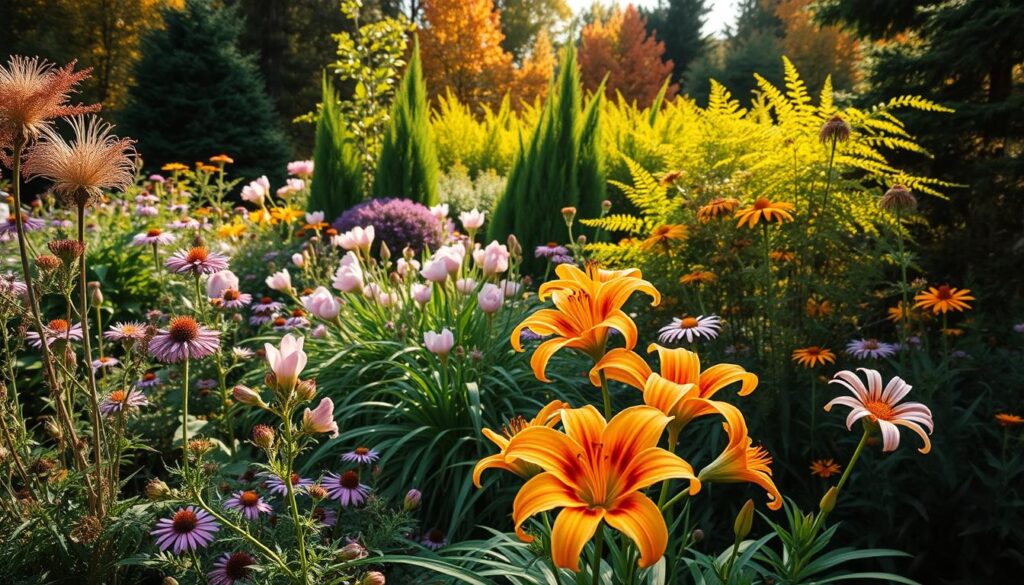
Maintaining a Healthy Garden Ecosystem
To create a thriving garden, you need to focus on consistent garden maintenance practices that keep your companion plants in optimal condition. Healthy plants contribute to a balanced ecosystem, making your garden more resilient to pests and diseases. Emphasizing organic pest control methods can further enhance the health of your plants while promoting an environmentally friendly approach.
Regular Maintenance for Companion Plants
Engaging in routine maintenance is essential for the overall success of your garden. Frequent actions include:
- Weeding: Remove unwanted plants to reduce competition for nutrients.
- Pruning: Trim dead or overgrown branches to promote air circulation.
- Mulching: Apply organic materials to retain soil moisture and suppress weeds.
Organic Solutions for Pest Management
Using organic methods for pest control can significantly enhance the stability of your garden ecosystem. Consider these effective strategies:
- Introduce beneficial insects like ladybugs and lacewings that help manage harmful pests.
- Utilize companion planting techniques to create natural barriers against pests.
- Apply organic sprays made from neem oil or insecticidal soap to protect your healthy plants.
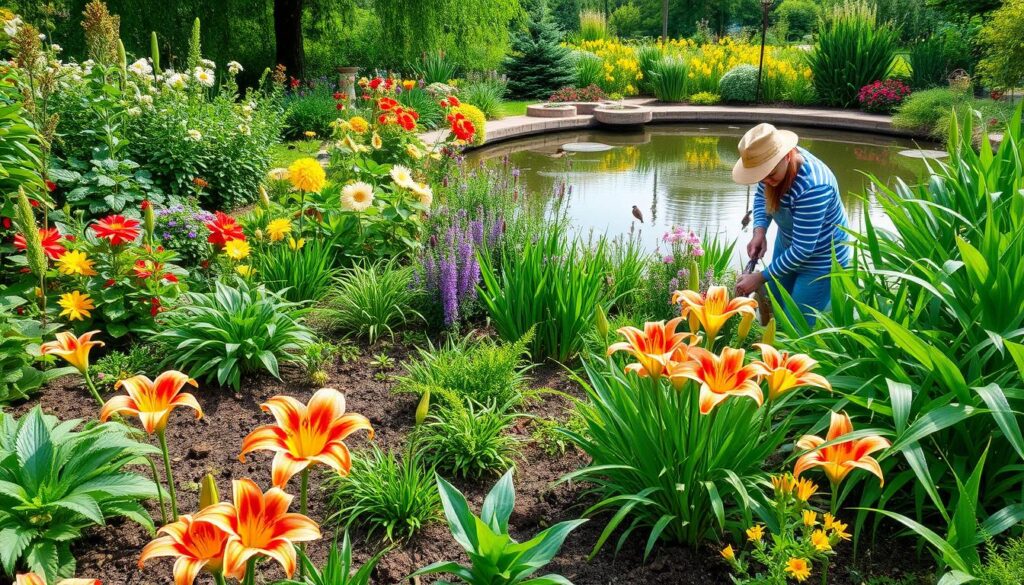
Educational Resources on Companion Planting
Expanding your knowledge in gardening can lead to successful planting and thriving gardens. Exploring various avenues for companion planting education is essential. Books on gardening practices can provide in-depth insights, while an online gardening community offers real-time tips and shared experiences.
Books on Gardening Best Practices
Books dedicated to gardening resources often cover diverse topics, including companion planting. Notable titles include:
- The Vegetable Gardener’s Bible by Edward C. Smith – A classic that discusses companion planting techniques.
- Carrots Love Tomatoes by Louise Riotte – Focuses on beneficial pairings and companion planting strategies.
- Rodale’s Ultimate Encyclopedia of Organic Gardening – Offers a comprehensive look at organic gardening methods integrating companion plants.
Online Communities and Forums
Joining an online gardening community can be invaluable for advice and support. Websites such as Reddit’s gardening forum and GardenWeb provide platforms to ask questions, share experiences, and discover innovative planting combinations. Here, you can connect with individuals who have a wealth of knowledge, leading to enriched companion planting education.
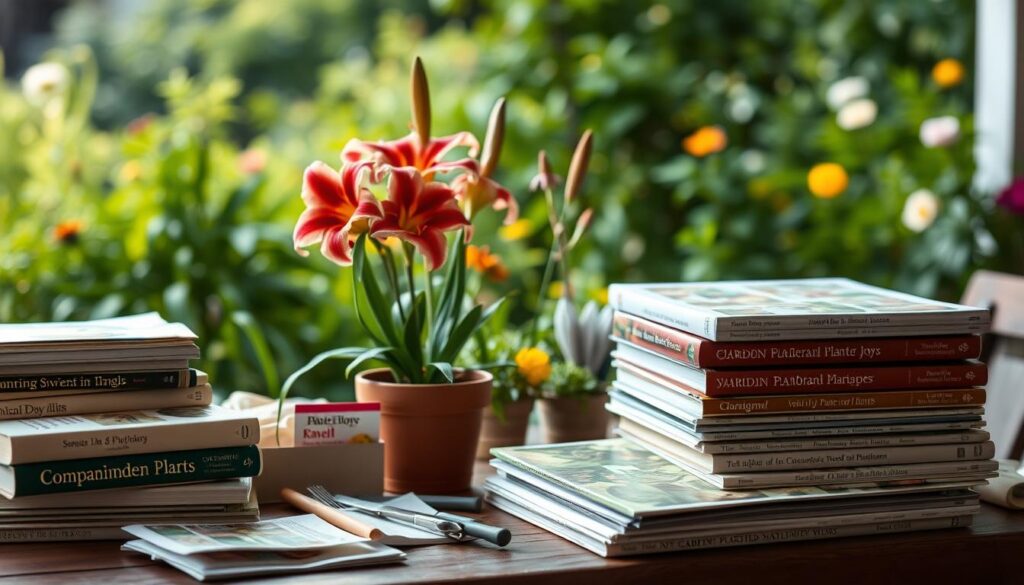
Exploring Creative Garden Designs
Enhancing your garden through creative design opens up exciting possibilities for visual appeal. By integrating thoughtful color pairing, varying plant textures, and heights throughout your space, you can create a mesmerizing sanctuary. Whether you’re focused on daylilies or other ornamental plants, these garden design ideas will help you craft a vibrant landscape.
Pairing Colors in Your Garden
Color pairing serves as a foundation for achieving a stunning garden. Combining complementary hues can create striking contrasts that highlight each plant’s beauty. For instance, pairing bright yellow daylilies with deep purple salvias can energize the space, while soft pastel hues can evoke tranquility. Embrace seasonal colors and consider how different shades interact to ensure your garden remains visually engaging year-round.
Textures and Heights: Creating Interest
Incorporating diverse plant textures elevates your garden’s overall aesthetic. The contrast between smooth daylily foliage and the fuzzy leaves of lamb’s ear creates depth. Similarly, mixing plants of varying heights, from towering sunflowers to low-lying ground covers, adds layers that appeal to the eye. Aim for a harmonic blend where each element complements the others, resulting in a visually arresting display.
| Plant Type | Color Option | Texture | Height Variation |
|---|---|---|---|
| Daylily | Yellow | Smooth | 30-36 inches |
| Salvia | Purple | Fuzzy | 12-30 inches |
| Lamb’s Ear | Silver | Soft | 10-12 inches |
| Sunflower | Gold | Rough | 48-96 inches |
| Ground Cover (Creeping Thyme) | Green | Fine | 2-4 inches |
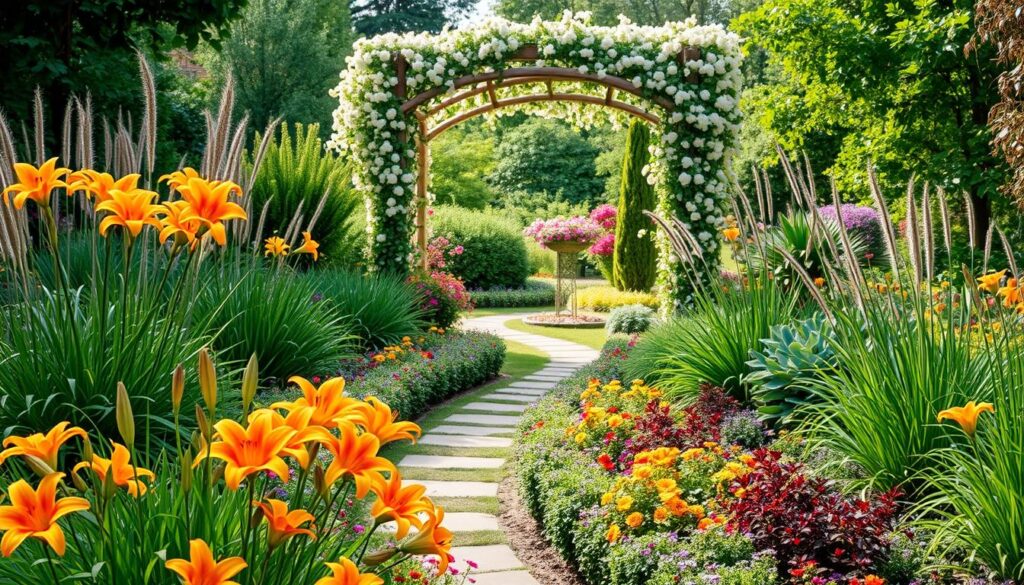
Conclusion: Creating Your Perfect Garden
As you consider the potential for your daylily garden success, it’s essential to reflect on the remarkable benefits of companion planting. Understanding how different plants can work harmoniously together not only enriches the visual appeal of your garden but also promotes healthier growth and ecological balance. The perfect garden combinations often arise from the careful selection of companions that enhance each plant’s strengths while mitigating weaknesses.
Summary of Companion Plant Benefits
Companion planting offers numerous advantages, from improved soil quality to natural pest control, creating a vibrant and resilient garden landscape. Daylilies, with their adaptability and stunning blooms, serve as an excellent base for exploring diverse partnerships. By integrating herbs, perennials, and flowering plants, you can achieve a dynamic and thriving environment that brings your garden to life.
Encouragement to Experiment with Partnerships
Remember, your garden is a canvas for creativity; don’t hesitate to delve into experimenting with plants to discover what works best for your space. By combining various species and observing their interactions, you can create a personalized paradise that reflects your gardening style and preferences. Embrace the journey to uncover unique combinations that suit your vision and foster daylily garden success!
